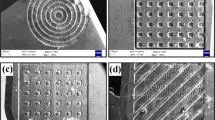Abstract
The use of high-speed milling (HSM) for the production of moulds and dies is becoming more widespread. Critical aspects of the technology include cutting tools, machinability data, cutter path generation and technology. Much published information exists on cutting tools and related data (cutting speeds, feed rates, depths of cut, etc.). However, relatively little information has been published on the evaluation of cutter paths for this application. Most of the research focuses on cutter path generation with the main aim on reducing production time. Work concerning cutter path evaluation and optimisation on tool wear, tool life and relevant workpiece machinability characteristics are scant. This paper investigates and evaluates the different cutter path orientations when high-speed finish milling inclined hardened steel, at a workpiece inclination angle of 75°. The results demonstrate that employing a vertical downward orientation achieved the longest life. However, in terms of workpiece surface roughness, vertical upward orientation is generally preferred.
Similar content being viewed by others
References
Wang H, Chang H, Wysk RA, Chandawarkar A (1987) On the efficiency of NC tool path planning for face milling operations. ASME J Eng Ind 109:370
Prabhu PV, Gramopadhye AK, Wang HP (1990) A general mathematical model for optimising NC tool path for face milling of flat convex polygonal surfaces. Int J Prod Res 128:101
Lakkaraju R, Raman S (1990) Optimal NC path planning: is it really possible? Comput Ind Eng 19:462
Jamil ATM (1998) A semi-analytical method of finding an optimum cutter path for face milling 3-sided convex surfaces. Int J Prod Res 36:343
Baptista R, Simoes JFA (2000) Three and five axes milling of sculptured surfaces. J Mater Process Technol 103:398
Gray P, Bedi S, Rao N, Morphy G (2001) Comparison of 5-axis and 3-axis finish machining of hydroforming die inserts. Int J Adv Manuf Technol 17:562
Schulz H, Hock S (1995) High speed milling of dies and moulds – cutting conditions and technology. CIRP Ann 44:35
Elbestawi MA, Chen L, Becze CE, El-Wardany CE (1997) High speed milling of dies and moulds in their hardened state. CIRP Ann 46:57
Tonshoff HK, Camacho JH (1989) Die manufacturing by 5- and 3-axes milling. J Mech Work Technol 20:105
Chu CN, Kim CY, Lee JM (1997) Feed rate optimisation of ball end milling considering local shape features. CIRP Ann 46:433
Ng EG, Lee DW, Sharman ARC, Dewes RC, Aspinwall DK (2000) High speed ball nose end milling of Inconel 718. CIRP Ann 49:41
Gaida WR, Rodriguez CA, Altan T, Altintas Y (1995) Preliminary experiments for adaptive finish milling of die and mould surfaces with ball nose end mills. Proceedings of the North American Manufacturing Research Conference (NAMRC XXIII), Houghton, MI, 1995, pp 193–198
Toh CK (2003) Tool life and tool wear during high speed rough milling using alternative cutter path strategies. J Eng Manuf 217:1295
Toh CK (2003) Surface topography analysis when high speed rough milling hardened steel. Mater Manuf Process 18(6):849
Toh CK (2003) A modified offset strategy for high speed rough milling hardened steel. J Eng Manuf 217(8):1161
Toh CK (2004) Static and dynamic cutting force analysis when high speed rough milling hardened steel. Mater Des 25:41
Toh CK (2004) Vibration analysis when high speed rough and finish milling hardened steel. J Sound Vib 278(1–2):101–115
Toh CK (2004) Surface topography analysis in high speed finish milling inclined hardened steel. Precis Eng 28(4):386–398
Dimla DE, Lister PM (2000) On-line metal cutting tool condition monitoring I: force and vibration analysis. Int J Mach Tool Manuf 40:739
Ng EG, Lee DW, Dewes RC, Aspinwall DK (2001) Experimental evaluation of cutter orientation when ball nose end milling Inconel 718. J Manuf Process 2:108
Kang MC, Kim KK, Lee DW, Kim JS, Kim NK (2001) Characteristics of inclined planes according to the variations of cutting direction in high speed ball end milling. Int J Adv Manuf Technol 17:323
Toh CK (2003) Evaluation of cutter path strategies and orientations when high speed milling hardened AISI H13 hot work tool steel. Dissertation, University of Birmingham
Rodriguez CA, Altan T (2000) Effect of process parameters upon tool wear of ball nose end mills. Proceedings of the North American Manufacturing Research Conference (NAMRC XXVIII), Lexington, KY, 2000, pp 221–226
Chou YK, Evans CJ (1999) Cubic boron nitride tool wear in interrupted hard cutting. Wear 225:234
Nelson S, Schueller JK, Tlusty J (1998) Tool wear in milling hardened die steel. ASME J Manuf Sci Eng 120:669
Lim EM, Feng HY, Menq CH, Lin ZH (1995) The prediction of dimensional error for sculptured surface productions using the ball end milling process, part 1: chip geometry analysis and cutting force prediction. Int J Mach Tool Manuf 35:1149
Ning Y, Rahman M, Wong YS (2001) Investigation of chip formation in high speed end milling. J Mater Process Technol 113:360
Sai WB, Salah NB, Lebrun JL (2001) Influence of machining by finish milling on surface characteristics. Int J Mach Tool Manuf 41:443
Abrari F, Elbestawi MA, Spence AD (1998) On the dynamics of ball end milling: modelling of cutting forces and stability analysis. Int J Mach Tool Manuf 38:215
Author information
Authors and Affiliations
Corresponding author
Rights and permissions
About this article
Cite this article
Toh, C. Cutter path orientations when high-speed finish milling inclined hardened steel. Int J Adv Manuf Technol 27, 473–480 (2006). https://doi.org/10.1007/s00170-004-2206-4
Received:
Accepted:
Published:
Issue Date:
DOI: https://doi.org/10.1007/s00170-004-2206-4




